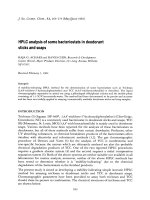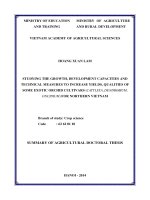Analysis of science and technology policies: Perspectives and challenges
Bạn đang xem bản rút gọn của tài liệu. Xem và tải ngay bản đầy đủ của tài liệu tại đây (169.43 KB, 10 trang )
Analysis of science and technology policies:perspectives and challenges
42
ANALYSIS OF SCIENCE AND TECHNOLOGY POLICIES:
PERSPECTIVES AND CHALLENGES
Ass. Prof. Dr. Dao Thi Ai Thi
Management Training Institute
Abstract:
All policy ideas have roots from the human mindset, shape from practice then present, push
up and have purpose to solve practical problems. This report does not target to analyze
existing policies as well as their impacts to socio-economic effects of Vietnam. The report is
focused on studies of some basic matters, namely: i)Brief note on the importance of
analysis of science & technology (S&T) policies; ii) Interpretation of some types of mindset
and their impacts of these types of mindset in analyzing S&T policies in Vietnam; iii)
Analysis of shortages of S&T development of Vietnam in a global manner; iv) Perspectives
and challenges for S&T development of Vietnam as seen by analyzers for the selection of
policies as well the persist existence of rice-cultivation culture and small-scaled agriculture
which Vietnam is facing now.
Keywords: S&T policies; Policy analysis.
Code: 13090303
1. Why is the analysis of S&T policies?
S&T policy analysis in practical S&T context of Vietnam is to show how
the S&T platform is: high or low, strong or weak. It is also a problem for
S&T policy analyzers of Vietnam to see more clearly the importance of
S&T analyzing capacities as we have today.
S&T policy analysis is to make plans, then issue, implement and evaluate
the effect of policies. The policy analysis is to show the existing problems
of S&T policies in passed, present and future times to have visions to
existing problems and needs to renovate S&T policies. Particularly, the
analysis would identify perspectives and challenges which Vietnamese S&T
policy makers are facing.
S&T policy analysis is to provide interpretations of aspects, positive or
negative, then to select optimal options for background to issue effective
policies in practice.
S&T policy analysis is to set up plans and to build policies of strategic
visions for national S&T development and, at the same time, to build
concrete policies for key-important, specific and spearheading fields.
JSTPM Vol 2, No 3, 2013
43
S&T policy analysis is to plan, issue and implement policies in scientific
manner, to foresee advantages and disadvantages of policies then to select
the most suitable policies. The set up of “strategies”, “programs” or
“visions” for S&T development actually lacks a right analysis and this
situation leads to the lack of scientific background for these policies.
S&T policy analysis is to build strategies for S&T development including
various topics, namely:
(1) Right evaluation of the actual status and the analysis of hard problems of
S&T development of Vietnam.
(2) Right definition of objectives and requirements of renovation for S&T
development of Vietnam in certain period of time, i.e. “10 years strategies”
or “15 years strategies”.
(3) Choice of priorities for spearheading S&T fields, the selection of
orientations, paths, resources and measures for S&T development.
(4) Learning, absorption and application of the world’s advanced S&T
models.
(5) Establishment of favorable conditions for Vietnamese scientists to
conduct creative activities and mobilize all the capacities for their
participation and integration in the modern S&T activities of the world.
(6) Issuing policies to attract and maximize the use of S&T talents, the
formation of excellent scientists for better contribution to socio-economic
development of the country.
(7) Improvement of S&T organizations in all the economic, political,
cultural and social aspects of the country.
Briefly, the S&T policy analysis is to show out the internal nature of the
matter as well as the nature of links and interactions of natural and social
sciences in terms of policies. The S&T policy analysis is to indicate
problems related to bureaucratism, corruption and other problems of S&T
policies under political, economic, cultural and social optics. At the same
time, the S&T policy analysis is to see clearly the orientations and
movements of natural and social laws that S&T policy makers should
understand and act in conformity to laws but not “force” them or go against
them.
In its nature, S&T policies decide policies of training and education. S&T,
as training and education do, starts from demands of life and national
capacities. Therefore, the S&T policy analysis is the key to open S&T doors
for all the fields, economic, political, social, security and national defense.
44
Analysis of science and technology policies:perspectives and challenges
2. Some problems of mindset changes in S&T policy analysis
The human thinking capacities are extremely wonderful. The problem “S&T
can develop or not” depends on right and adequate policies. The problem “a
policy is right and adequate or not” depends on thinking capacities of
analyzers and the selection of policies. The effective analysis of S&T
policies depends much on the human thinking capacities.
The human mindset is divided into 5 aspects, namely:
First, the mindset has legal orientations
The legal mindset is based on exactness of thinking which is not impacted
by subjective wills in analysis of S&T policies. This type of mindset
emphasizes the value of reasoning, respects the principal concepts and the
justice. The development of mindset in this legal direction helps to keep the
S&T policy analysis in right and exact way. However, in practice the right
application does not always give right answers. Applying Ho Chi Minh
doctrine: “Keep the unchanged platform to face the changing
circumstances” for this type of mindset, we need to position policies in right
historical contexts and to avoid the once-for-ever approach in analyzing and
selecting policies.
Second, the mindset has subjective orientations
The subjective mindset in S&T policy analysis is usually based on personal
sensing perception of individuals. The sensing tendency in searching,
analyzing and assessing information usually leads to impulsive and
improvising perception without scientific background in analyzing and
selecting S&T policies. This type of mindset in S&T policy analysis leads to
wrong practice of works which would cause heavy consequences for
management activities in general and S&T activities in particular.
The partial mindset leads to unclear perception and judgment and to
difficulties in defining strong and weak points of policies and in executing
rights and liabilities in S&T activities. The consequences are the practice of
S&T policy analysis which is not based on scientific and practical
background and make S&T resources lost. This practice leads also to formal
scientific research works and wrong issuance of certificates. Then this
wrong application cannot solve socio-economic problems and may lead to
confusing perceptions of right and wrong, correct and false and etc. The
S&T policy analysis based on personal sensing mindset leads to the wrong
identification of values, cannot put S&T into practice and cannot bring real
effects.
JSTPM Vol 2, No 3, 2013
45
Third, the mindset has criticizing orientations
This type of mindset in analyzing and selecting S&T policies sees only
limited sides, shortages and errors of policies for blaming. It may lead to
extreme perception and judgment and has no measures to stimulate,
encourage and push up efforts to consider and identify problems.
In Vietnam, since the successful application of reform policies in 1986,
there appeared so many mindsets of criticizing nature. This new trend
naturally accelerated the reform process but contributed also to development
of extreme approaches of some policy analyzers and policy makers. They
changes without keeping the Eastern culture concepts of Viet peoples then it
leads to the issuance of inadequate S&T policies in certain fields which
cannot create driving forces for scientists, S&T based businesses and
technology appliers. “Brain drains” and low effects of scientific research
works and technological applications are the consequences of non-scientific
and inadequate policies.
Fourth, the mindset has optimistic orientations which encourage
creativity, and inventions
This type of mindset in analyzing and selecting S&T policies encourages in
developing advantageous sides of matters. For example, it stimulates
activities of scientists through reducing the administrative aspects of
scientific research works, provides particular incentive policies for
outstanding scientific research works and inventions.
This type of mindset has high humanity values and stimulates activities of
peoples. The analysis and selection of policies requires a lot of this type of
mindset which lead to effective practical activities.
Fifth, mindset has the objective nature, behavior orienting and controlling
actions
In their mindset, S&T policy analyzers and makers have two actions:
analyzing and synthesizing to issue the most correct decisions. The mindset
catches the objective movement laws of socio-economic life, natural and
social laws, and human psychology to make the most effective analysis and
selection of policies. The respect of objective laws in analyzing policies
helps to make interpretation, analysis and search of new directions of moves
which follow objective laws but not go against them.
The objective mindset helps analyze and select S&T policies in correct and
adequate ways. For example, the center-controlled economic policies
remain adequate for the wartime but not suitable for the construction period,
particularly for S&T development. For that reason, those who have the
46
Analysis of science and technology policies:perspectives and challenges
scientific mindset would change mechanisms to fit the objective laws. In
practice of the post-1975 period, the mindset for issuance of policies did not
fit the objective reality then it naturally leads to stagnation. After 1986, the
development of mindset to make shifts of policies and mechanisms, from
center-controlled management to market driven mechanisms, from
subsidizing mechanisms to self-controlling mechanisms, allowed to make
new development steps and to create driving forces for S&T development.
The objectivity is the crucial mindset aspect in analyzing and selecting S&T
policies and in combining the 5 above mentioned types of mindset.
The Prime Minister had signed Decision No. 418/QD-TTg dated 11 April
2012 to approve the S&T Development Strategies, 2011-2020 periods,
which includes the main contents such as the Concepts of S&T
development, Objectives of S&T development, Orientations of tasks of S&T
development and Main solutions. Ministry of Science and Technology
(MOST) had held the national conference for implementation of this
document. The 2013 amended S&T Law, substituting the one of 2000,
shows the results of a process of serious and objective analysis in the
innovative mindset.
It is possible to say that these documents contain the serious mindset which
gets updated to the civilized world’s level, improves the scientific research
management works. Particularly, they indicate the links between natural and
social sciences for regional and local socio-economic development on basis
of models from advanced nations. It is the perspective for the future
development of Vietnam.
3. Where is the S&T platform of Vietnam? Perspectives and challenges
3.1. Where is the S&T platform of Vietnam?
When we talk about “the platform”, we mean a solid background for S&T to
exist and develop. We usually mention the economy, culture, agriculture
and etc. The S&T platform is the key to open to other fields? This was
clearly seen through development periods of human civilizations.
S&T achievements in every historical period are marked by development
mark-stones of various civilizations. When the rice civilization developed, it
was the time of establishment of the agricultural civilization. This
agricultural civilization existed tenaciously in the human history,
particularly in Vietnam.
JSTPM Vol 2, No 3, 2013
47
The agricultural civilization has three main specific features: i) Existence of
the rice culture; ii) Main economic role of cultivating and livestock
breading; and iii) Popular handicraft production.
The term of “platform” of the so-called “agricultural civilization” includes
the following basic components:
(1) Policies and mechanisms are of subjective and will-based nature. They
were formed from experience-based doctrines without any scientific
background.
(2) Close structure of villages, inside orientation without exploring and
renovating activities.
(3) Popular farmer psychology with short visions for immediate benefits of
their groups. The community orienting mindset leads to cover the
satisfaction of individual benefits without clear indication of individual
responsibilities.
(4) Poorly developed infrastructure without any plans for construction.
These 4 components of the agricultural civilization “platform” show the
lack of modern scientific knowledge and advanced technologies for socioeconomic development of the nations in general and of Vietnam in
particular.
James Watt invented steam machines which opened the gate into the
industrial civilized society with the following main features: i) Existence of
industrial civilization in pace with urbanization; ii) Main economic role of
industrial production; iii) Large use of machines.
These three main features make the composition of the following elements:
1) Policies and mechanisms orient to public interests and social welfares.
They are formed from scientific knowledge and objective laws.
2) Unified organization, urban development, outside orientation and high
level of S&T development.
3) High human development with highly respected disciplines.
4) Developed material facilities, modern technical tools, unified,
integrated and modern infrastructure.
The knowledge civilization has the following basic features: i) Global
knowledge, high technologies, developed knowledge economy, confirmed
personal values, developed individual capacities, clearly defined individual
responsibilities; ii) S&T market is extended, flexible, creative and
48
Analysis of science and technology policies:perspectives and challenges
innovative; iii) High combination of scientific and experience-based
knowledge which creates highly effective productivity.
The knowledge civilization is composed of the following elements:
1) Policies and mechanisms orient to systems of global values which
created favorable conditions for development and global technology
transfer.
2) Multi-faceted organization with flat world concepts and optimal S&T
socialization.
3) Liberated human and labor resources which put end to all constraints.
4) Strong development of material conditions and software technologies,
intellectual products gain respects and sustainable development.
The three developed human civilizations are studied to provide the insight
for the S&T reality of Vietnam then it provides the vision where it locates
and which civilization it gets influenced from. Vietnam does not have a
strong S&T take-off because of the long lasting and tenacious existence of
the agricultural civilization and the rice culture. Scientific research and
technological development are still impacted from small-scaled farmer
production process which is dispersed, fragmented, formal and nonintegrated. The Vietnamese S&T does not have breakthrough moves
from barriers of bureaucratic and administrative concepts and behaviors
in activities of scientific research and technological development.
The most expression of bureaucratic and administrative management is
the concepts to equate sciences and powers which means that the high
power ranked persons in any organization would have the commanding
role in scientific fields of that organization. Similarly, the outcomes of
research works are evaluated by the number of reports’ pages to be
presented and the volume of administrative formalities to be completed.
This situation leads to the lack of a perfect science of S&T policy
analysis.
From another side, there exists a habitude to follow experiences which can
expressed, by other words, as “farmerization” of scientific activities. It
means also the low level of passions for scientific research of experts and
scientists. Instead of that there are passions for benefits and money earning
and the “administration” of scientific research activities. The bureaucratic
and heavy administrative mechanisms make real scientists and experts lose
their passion and stimulation for creative work because they cannot stand
outside of the common law which says “the social existence decides the
JSTPM Vol 2, No 3, 2013
49
social awareness”. This practice leads to consequences of impracticable
policies.
The “farmerized” S&T platform means the scientific research is bound
with experience-based doctrines, formal approaches, individual benefits and
simplified, easy and impartial evaluation of scientific research results.
All of these “administration, bureaucratization, farmerization” lead to the
basic lack of real scientific knowledge, breakthrough scientific research
(particularly in fields of public policies and public administration) to untie
labors (workers, scientists or farmers), to untie the practice of outdated and
conservative customs and habits which last hundred years in Vietnam.
It is possible to say that these basic features of the Vietnamese S&T
platform create the unconsolidated corner stones for its development.
Chemicals were mixed incorrectly to “water” this platform, and even the
“watering” was made it was made incorrectly. This unconsolidated and
inadequate platform, in majority of cases, comes from the fields of S&T
policies and mechanisms. Also, where these policies come from? They do
not fall down from the high sky and they do not come up from the deep
ground. They are products of human activities. Then this problem remains
the huge challenges for S&T development in Vietnam.
3.2. What are the perspectives of Vietnam?
There is no absolutely good policy to be applied for all the historical
periods. The most important matter is policies analyzers should have the
mindset to fit the actual historical situation. There is no chance to have the
modernization and the industrialization when the human mindset remains
the one form small scaled and fragmented agriculture production. There is
no chance to have S&T advances when we still keep strongly the mindset
which comes from an outdated agricultural economy. We are difficult to
enter the industrial and intellectual civilization with the heavy and tenacious
legacies from the rice culture and agricultural civilization without
breakthrough moves of innovation. Therefore, the innovation of mindset is
needed to fit the requirements of the historical period and to meet the
demands of the future.
What are the perspectives of S&T development of Vietnam? Maybe they
remain as potentials despite of rich natural and human resources.
However, this problem had gained the signs of change since 2011. Vietnam
has issued some breakthrough policies such as the 2013 National Program
of Technological Innovation, S&T Development Strategies up to 2020 and
the 2013 Amended S&T Law.
50
Analysis of science and technology policies:perspectives and challenges
3.3. What are the challenges for S&T development in Vietnam?
The S&T development of Vietnam is facing many opportunities as well as
difficulties and challenges because it wishes to enter the “industrial
civilization” where many advanced countries in the world are for more than
a century. We are still lacking a “basic policy background” to play the role
of corner stones for development to meet the objective of Vietnam to
become basically an industrial and modern country by 2020 as indicated by
the Socio-Economic Development Strategies. This would put down hard
questions to S&T policy analyzers is they are capable of analyzing and
making S&T policies in the most adequate way.
What is to do to know where we are and where we want to go in terms of
S&T development? It turns out to be a whole process of works to monitor,
supervise and evaluate S&T policies in the passed, present and future times.
Here the challenges are the lack of a system of clear indicators for
evaluation and we still base consideration on the side of sensing mindset.
We are deviated not only in our mindset but also in our senses. They are
values difficult to be measured. We have only senses that somewhere S&T
policy makers remain “without senses” in their duties to make policies
during many last years. The so-called “without senses” here is in fact the
expression of bureaucratism in issuance of policies without background of
practice and analysis of policies.
Resource for S&T development remains as potentials because during many
last years, the S&T policies were “bureaucritized, administrialized and
farmerized” so the potential have no nurturing and developing environment,
particularly for potentials of S&T human resources. The brain drain is a
huge challenge for S&T development of Vietnam.
Therefore, the S&T policy analysis is an extremely important work to start a
procedure of setting up S&T policies which is also the ending point of this
procedure. Perspectives and challenges for S&T development of Vietnam
put down a difficult problem for S&T policy analysis that we have to have
peoples full of capacities to foresee the perspectives and, as S&T policy
makers, to produce policies with their heart and qualification. At the same
time, they should be capable of finding challenges to face and be strong
enough to overcome mediocre values and tiny and selfish benefits. S&T
advances have no space for tiny and selfish thinking as well as for
conservative and outdated policies, dogmatic and bureaucratic doctrines,
corruption and individual benefits.
JSTPM Vol 2, No 3, 2013
51
Finally, the perspectives of S&T development of Vietnam keep pace with
the challenges risen by S&T policies. Policies can create a good
environment, driving forces and legal frameworks for S&T development.
Inversely, they could be a dead environment and huge barriers to S&T
resources of Vietnam./.
REFERENCES
1.
S&T Law, 2000.
2.
Amended S&T Law, 2005.
3.
Amended S&T Law, 2013.
4.
Decision No. 677/QD-TTg dated 10 May 2011 by the Prime Minister for approval of
the National Program of Technological Innovation, up to 2020.
5.
Decision No. 418/QD-TTg dated 11 April 2012 by the Prime Minister for approval of
S&T Development Strategies, 2011 - 2020 periods.









